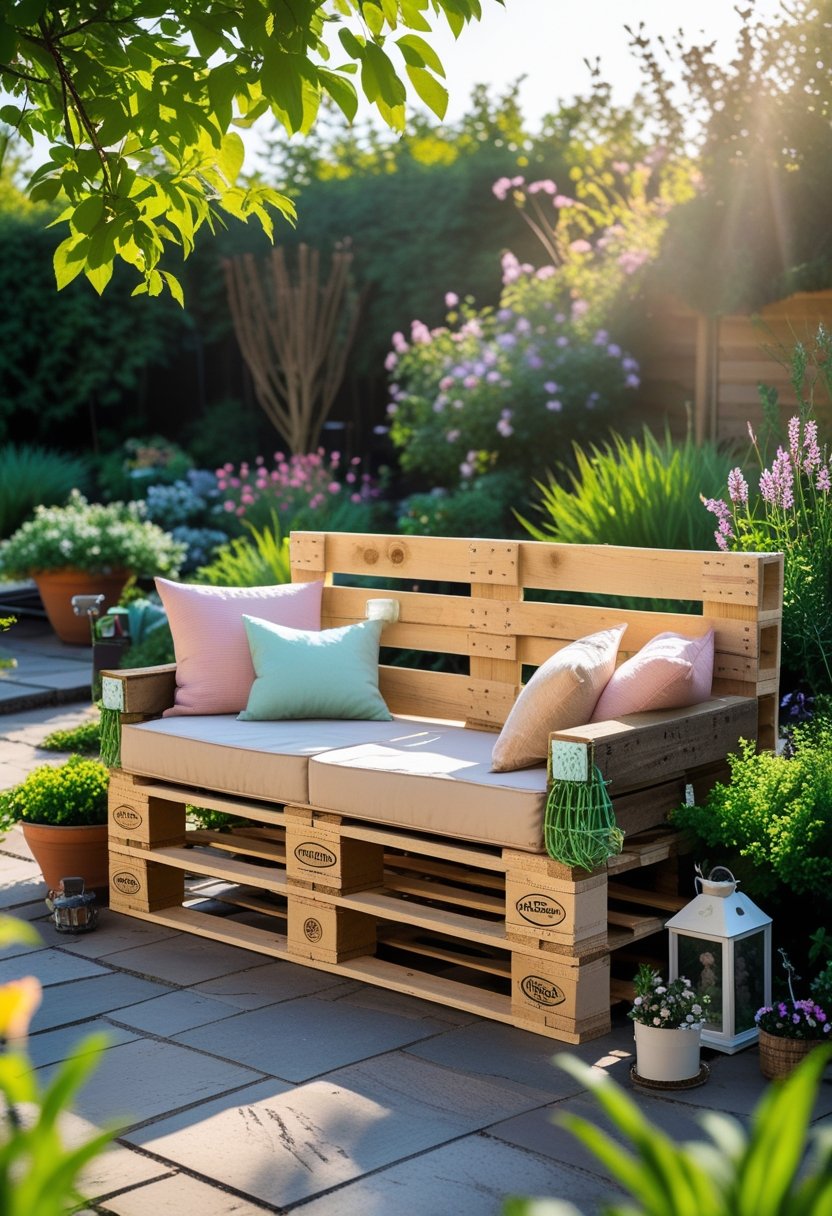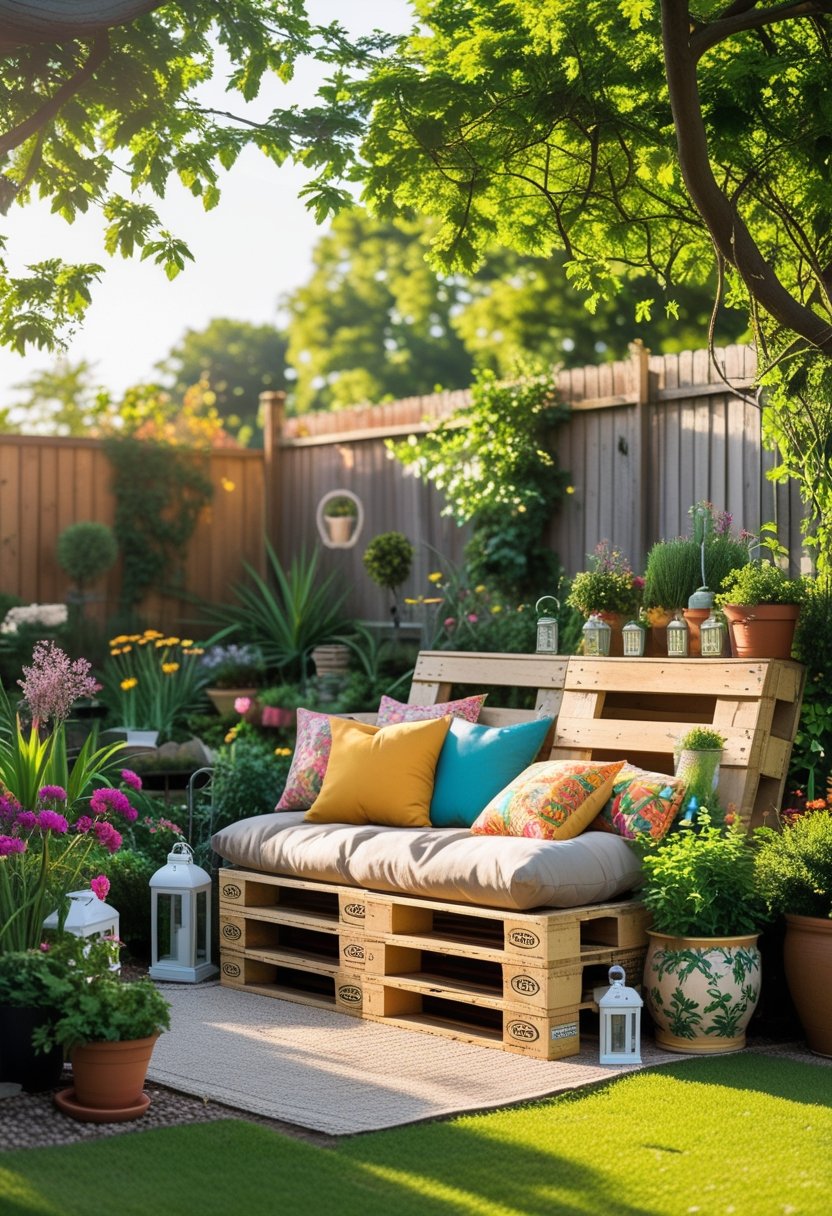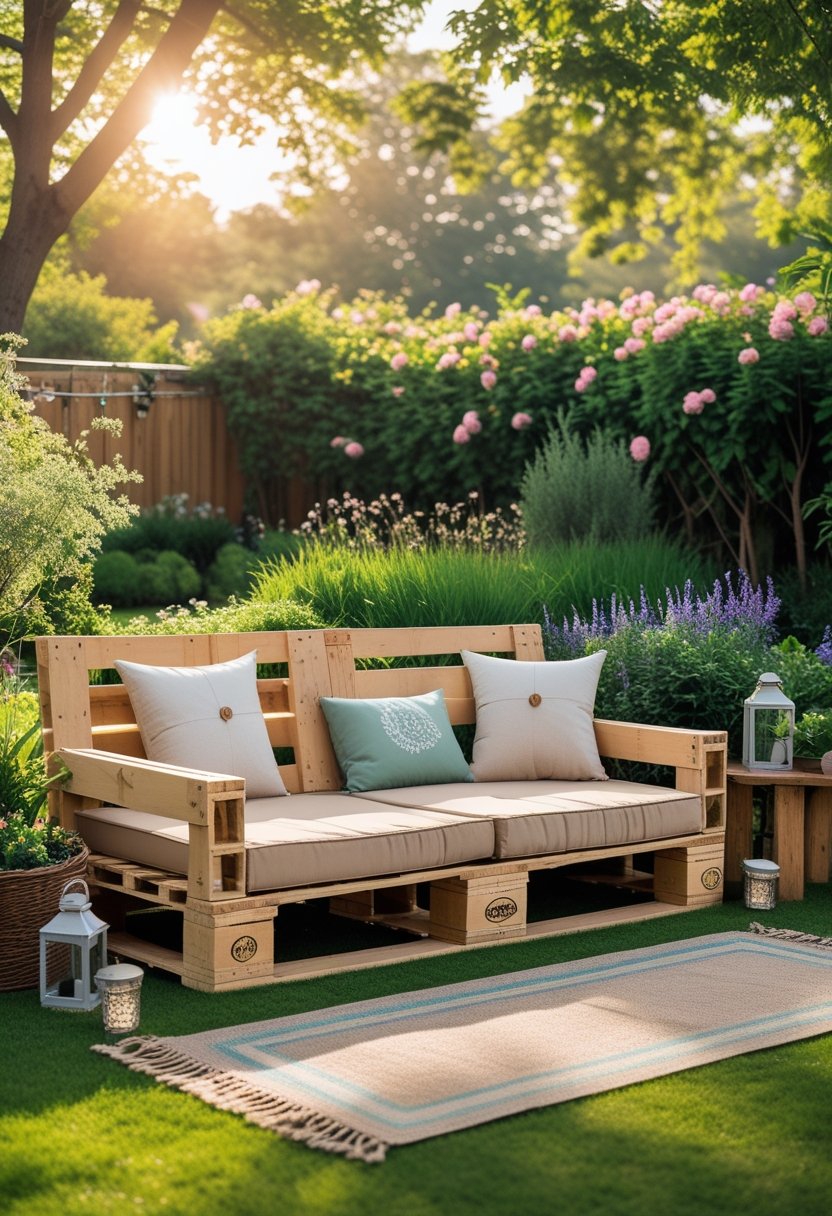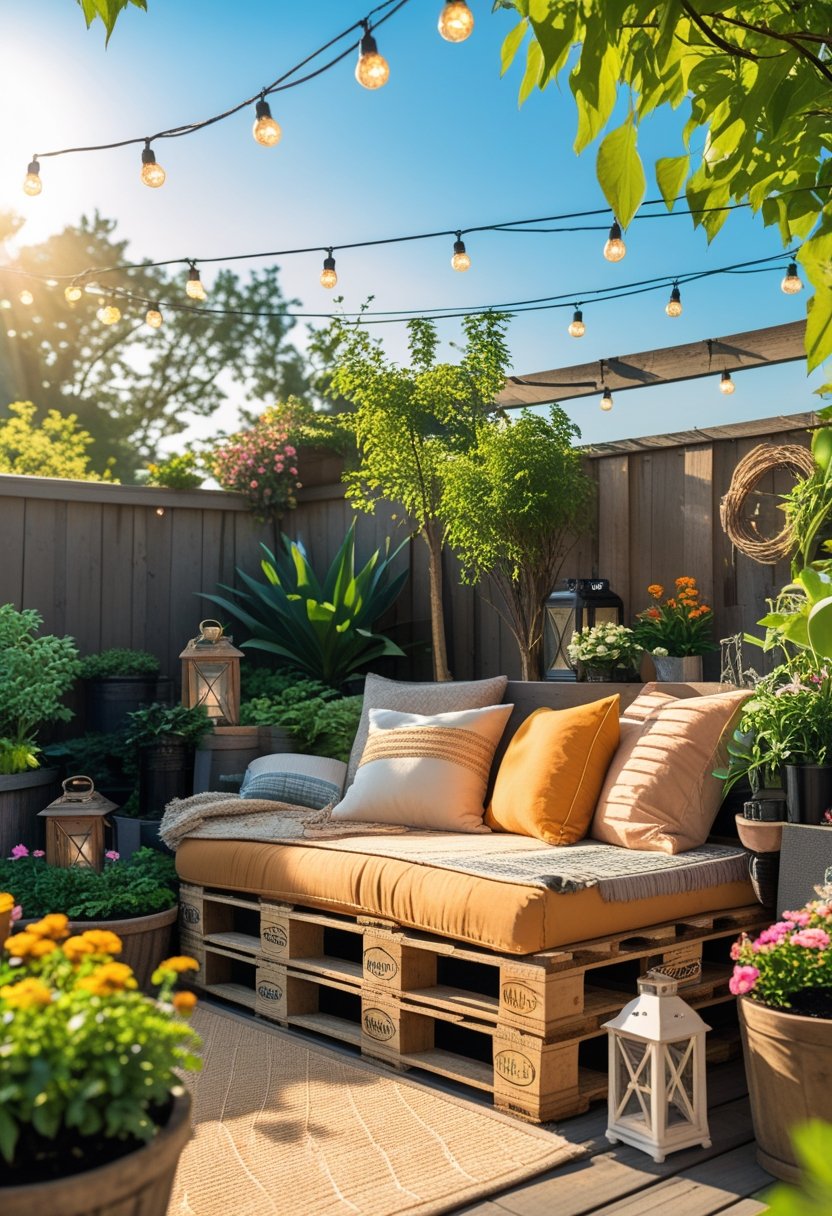DIY Pallet Garden Bench with Canopy & Yellow Cushions
Creating a sunny garden retreat can transform any outdoor space into a cozy, inviting oasis. This DIY pallet bench project combines rustic charm with modern comfort, featuring vibrant yellow cushions and a stylish curved canopy roof. Lush floral accents enhance the natural feel, making it perfect for backyard lounging and summer relaxation.

This pallet bench design offers an eco-friendly, cost-effective way to elevate garden décor while providing a comfortable seating area. Its blend of recycled materials and thoughtful details creates an Instagram-worthy spot that suits a variety of outdoor styles.
Whether the garden is spacious or compact, this project adapts well to different settings, encouraging both creativity and sustainability in outdoor living. It is ideal for anyone looking to add personality and function to their backyard without extensive resources.
Designing Your Sunny Garden Retreat

Creating a backyard retreat requires deliberate choices about location, layout, and furniture integration to maximize comfort and aesthetic appeal. The right spot balances sunlight and shade, while the design ensures fluid movement and makes the pallet bench the focal point of the garden space.
Choosing the Ideal Location
Selecting the location for the sunny garden retreat involves finding a spot with ample natural light but also some protection from harsh midday sun. A corner of the garden or a section near tall plants or a fence can offer both privacy and partial shade.
The area should have a flat, stable surface to support the pallet bench and canopy. Accessibility from the house is important for ease of use, especially if the space serves as an extension of a patio or outdoor dining zone.
Consider the backdrop—lush floral accents or climbing vines work well to frame the bench and enhance tranquility. The goal is a quiet, cozy nook that invites relaxation without disruption from garden traffic or noise.
Planning Space and Layout
Effective spatial planning ensures the garden retreat remains functional and comfortable. The area should allow enough clearance around the pallet bench for easy seating access and movement. A minimum of 3 feet around the bench is recommended.
Incorporate pathways connecting the retreat to other parts of the outdoor space, such as the patio or garden beds. Use natural materials like gravel or stepping stones to maintain a rustic ambiance.
Layering with potted flowers and low shrubs helps blend the retreat organically without overcrowding. Keep lounging accessories within reach but avoid clutter to maintain an inviting, tidy atmosphere.
Integrating the Pallet Bench Design
The pallet bench serves as both a practical seating solution and an eco-friendly statement. Position it where the curved canopy roof can provide sufficient shade from direct sunlight, promoting longer comfort during summer afternoons.
Bright yellow cushions add a vibrant contrast to the natural wood tones and surrounding greenery, creating an uplifting, cheerful spot. Ensure cushions are weather-resistant to extend durability outdoors.
Complement the bench with floral accents placed strategically around the base and canopy structure. Use a consistent color palette among the flowers to unify the look and enhance the garden retreat’s charm.
The bench’s rustic construction matches well with modern outdoor décor elements, balancing timeless appeal with current style for an Instagram-worthy backyard oasis.
Building the DIY Pallet Bench

This project focuses on choosing quality pallets, constructing a stable frame, and enhancing seating comfort with vibrant cushions. Each step contributes to a cozy garden bench that balances rustic style and practical durability for outdoor use.
Selecting and Preparing Pallets
Start by selecting pallets made of solid hardwood, avoiding those with visible cracks, splinters, or signs of mold. Pallets marked with “HT” (heat treated) are preferable because they are safer and free of chemical treatments.
Disassemble pallets carefully to preserve the wood planks. Use a crowbar and hammer to remove nails gently, preventing damage to the boards. Sand all surfaces to remove rough spots and splinters, progressing from coarse to fine grit, which ensures smoothness and comfort for seating.
Treat the wood with an outdoor sealant or weather-resistant stain. This protects the pallet bench from moisture and UV damage, extending its life in the garden setting.
Assembling a Sturdy Frame
Begin by laying out the base using the longest, most robust pallet planks for stability. Secure the frame with outdoor screws and wood glue at joints for extra strength. Reinforce corners with metal brackets if necessary.
Build the bench seat by attaching horizontal planks across the frame and then add vertical supports for the backrest. Install a curved canopy roof using bent wooden slats or flexible planks, ensuring it is anchored securely to provide shade and shelter.
Balance the bench structure to prevent rocking or wobbling. All parts must fit tightly to support comfortable lounge seating without sagging or instability.
Adding Comfort with Yellow Cushions
Choose cushions made for outdoor use, resistant to water, fading, and mildew. Bright yellow cushions should be thick enough to provide softness but firm enough to support prolonged sitting in the garden.
Secure cushions with ties or non-slip pads to keep them in place during wind or movement. Arrange cushions to cover the seating area and backrest evenly for a cohesive look.
Add floral accent pillows to enhance the visual appeal. The combination of sturdy construction and cushioning creates a cozy seating spot ideal for sunny garden retreats.
Adding a Curved Canopy Roof for Style and Shade

A curved canopy roof combines aesthetic appeal with practical shade and shelter. Using durable materials and thoughtful construction techniques ensures the structure is both sturdy and visually pleasing. Integrating outdoor lighting can enhance ambiance and usability during evening hours.
Materials for a Modern Curved Canopy
Choosing the right materials is essential for durability and style. Common options include aluminum for a sleek, lightweight frame and treated wood for a rustic, natural look. Polycarbonate or waterproof fabric panels offer weather protection and filter sunlight without blocking airflow.
Steel brackets and corrosion-resistant screws provide secure joints. For the canopy cover, UV-resistant fabric improves longevity and protects against harsh sun rays. Clear or tinted polycarbonate sheets also allow natural light while shielding from rain.
Incorporating materials that are easy to maintain and weatherproof will extend the life of the canopy and keep the outdoor space comfortable in varying conditions.
Constructing the Roof Structure
Building a curved canopy requires precise measurements and secure framing. Start with bending flexible wood strips or metal tubing to form the curve shape. Attach these to sturdy vertical posts anchored firmly into the ground or patio base.
Crossbeams spaced evenly along the curve provide support for the canopy covering. Fastening the frame with metal brackets increases stability under wind or rain. Using a ledger board to fix one side to an existing wall can improve structural integrity.
Careful alignment and tensioning of the canopy material prevent sagging and ensure a clean, streamlined appearance.
Achieving Effective Shade and Shelter
A curved canopy can offer ample shade while maintaining an open, airy feel. Position the curve to block the harshest sun angles during peak hours. Installing retractable or adjustable fabric panels allows control over light and ventilation.
Adding outdoor lighting such as integrated LED strips along the frame can brighten the space without compromising shade. Waterproof fixtures ensure safety and durability.
This design protects against sun and light rain, encouraging longer use of the garden retreat. The balance of shade and airflow creates a comfortable environment ideal for relaxation or socializing.
Enhancing with Lush Floral and Green Accents

A vibrant garden retreat thrives on well-chosen greenery and floral elements that complement the pallet bench’s rustic style. Strategic planting height, texture, and color create depth and inviting layers around the seating area, making the space feel alive and balanced.
Incorporating Raised Garden Beds
Raised garden beds offer a structured way to introduce greenery without overwhelming the space. They can be built from natural wood or repurposed pallets to maintain the rustic aesthetic.
Using beds around the bench’s perimeter or along pathways adds vertical height and defines zones within the garden. Raised beds help with soil drainage and easier plant maintenance, making them practical for flowers, herbs, or small shrubs.
Position tall plants or ornamental grasses at the back of the beds to create a natural screen and privacy barrier. Layer shorter plants, such as succulents or ground covers, toward the front for variety.
Arranging Potted Plants and Vertical Gardens
Potted plants bring versatility by allowing easy rearrangement to suit changing light or seasonal blooms. Grouping pots of different sizes and heights near the bench enhances visual interest.
For vertical gardens, trellises or wall-mounted planters conserve floor space while adding lush greenery upwards. This is especially effective in smaller yards where horizontal planting is limited.
Using climbers like jasmine or clematis on vertical structures adds fragrance and softens the canopy’s edges. Potted plants can include a mix of foliage types—broad leaves, spiky forms, and trailing vines—to create texture contrasts.
Blending in Vibrant Flower Displays
Colorful flowers are essential to brighten the garden retreat. Seasonal blooms in yellows, whites, and purples harmonize well with the yellow cushions and natural wood tones.
Cluster flowers in groups for impact rather than scattering them individually. This approach creates a statement without cluttering the space.
Plant varieties such as marigolds, zinnias, or cosmos provide long-lasting color and are suited for small garden settings. Incorporate flowers that attract pollinators to encourage biodiversity and subtle movement.
Using floral accents near sitting areas invites a relaxing sensory experience through both sight and scent.
Creating Atmosphere with Outdoor Lighting and Décor

Effective outdoor lighting and carefully chosen décor elements establish a warm, inviting ambiance for a garden retreat. Strategic use of lights enhances the visual appeal and extends usability into the evening. Complementary accessories, such as wind chimes and lanterns, contribute to both style and sensory experience.
Installing String and Twinkling Lights
String lights are essential for adding soft illumination around seating areas and pathways. They can be draped along the curved canopy roof to highlight its structure and create a cozy glow. Opt for warm-colored LED bulbs to maintain a relaxing atmosphere.
Twinkling lights add subtle movement and sparkle, enhancing the peaceful vibe after dusk. Solar-powered versions provide convenient, eco-friendly lighting without the need for wiring. Position these lights overhead or woven through nearby plants to create depth and interest.
Regular maintenance ensures optimal brightness and safety. Use outdoor-rated cables and waterproof connectors to withstand weather conditions. Proper installation secures the lights firmly against wind or rain.
Decorating with Lanterns and Wind Chimes
Lanterns provide focused pools of light and decorative appeal. Grouping a few lanterns around the pallet bench or garden corners creates intimate zones for relaxation. Choose styles that complement rustic or modern aesthetics, like metal or wicker finishes.
Wind chimes introduce gentle, natural sound into the outdoor space. Place them near seating areas or entrances to encourage a calming sensory element. Materials such as bamboo or metal chimes fit well with an eco-friendly garden theme.
Both lanterns and wind chimes should be positioned thoughtfully to avoid clutter while maximizing their functional and aesthetic contributions to the space.
Selecting Accessories for Modern Comfort
Accessories should balance rustic charm with practical comfort. Vibrant yellow cushions on the pallet bench provide both a visual pop and comfortable seating. Consider weather-resistant fabrics that can withstand sun exposure and moisture.
Add throw pillows or small side tables to support leisurely activities such as reading or sipping drinks. Incorporate planters with lush florals or greenery to frame the seating area and create a natural enclosure.
Include elements like shade curtains or a compact fan for climate control during hot days. These details make the garden retreat inviting, comfortable, and usable for longer periods.
Personalizing Your Outdoor Oasis

Creating a truly inviting outdoor space requires thoughtful additions that enhance comfort, privacy, and ambiance. Selecting the right elements such as screening solutions, focal features, and designated relaxation areas will elevate the overall experience.
Integrating Privacy Solutions
Privacy is essential for a cozy garden retreat, especially in shared or urban settings. Installing tall hedges or lattice panels with climbing plants creates subtle yet effective barriers. These natural screens maintain openness while blocking unwanted views.
For a modern touch, privacy screens made from wood or metal can be arranged to allow airflow and dappled sunlight. Using movable panels or outdoor curtains attached to the pallet bench canopy also offers flexible privacy control.
Plants like bamboo or ornamental grasses add texture and softness while serving as living fences. Combining structural and natural elements ensures both seclusion and aesthetic appeal.
Adding Features like Fire Pit or Water Elements
Fire pits provide warmth and a social focal point for evening gatherings. A simple stone or metal fire bowl tucked near the pallet bench enhances usability during cooler months. It encourages lingering conversations and outdoor enjoyment after sunset.
Water features, such as small fountains or serene pond-like basins, introduce calming sounds to the space. Positioning a water element close to seating areas adds sensory depth without overwhelming noise.
Both fire and water features should be sized proportionately to the garden space. Thoughtful placement ensures balance between functionality and maintaining an open, inviting atmosphere.
Including Relaxation Zones: Hammocks and Garden Swings
Designating specific spots for relaxation improves the retreat’s usability. Hammocks offer a lightweight, casual lounging option ideal for reading or napping, often hung between sturdy trees or posts.
Garden swings provide gentle motion and a nostalgic charm, fitting neatly alongside the pallet bench area. Choosing weather-resistant materials and coordinating cushions in vibrant yellow tie the pieces together visually.
Combining different seating types supports varied uses—quiet reflection in a hammock or social interaction on the swing. These zones create layers of comfort throughout the garden.
Setting Up an Outdoor Dining Area
An outdoor dining area completes the multifunctional quality of the oasis. A compact table with matching chairs or benches, ideally placed with shade overhead, facilitates meals and gatherings.
Incorporating foldable or modular furniture helps maximize space flexibility. Adding string lights or lanterns increases usability into the evening hours.
Details like weatherproof tableware and a nearby serving station improve convenience. Keeping dining elements coordinated with the colorful cushions and rustic wood pallet style maintains aesthetic unity.

Ana Luisa
Explore in-depth biographies, net worth insights, and exclusive updates on your favorite singers at Trionua.com. Discover the journeys, achievements, and latest news about music’s biggest stars.






